View in other NatureServe Network Field Guides
NatureServe
Montana
Utah
Wyoming
Idaho
Wisconsin
British Columbia
South Carolina
Yukon
California
New York
Snowshoe Hare - Lepus americanus
Native Species
Global Rank:
G5
State Rank:
S4
(see State Rank Reason below)
Agency Status
USFWS:
USFS:
BLM:
External Links
State Rank Reason (see State Rank above)
Species is common in montane environments and can be quite abundant at times. Increased variability of snow presence and loss of snow pack and decoupling of molting periods with snow presence may lead to declines in populations of this species through increased predation rates.
General Description
This large lagomorph is characterized by large feet and ears. Its pelage is brown for most of the year, but becomes white in the winter. Its large hind feet allow it to move easily over the snow. This species is an important prey item form mid to large sized forest carnivores. Although its range extends into the river bottoms and draws of eastern Montana, it is most frequently observed in the montane forests within the western and central regions of the state.
Diagnostic Characteristics
Snowshoe Hares can be separated from cotton-tail rabbits by size and general morphology, and from jackrabbits by the white outer margin of the ear which is present year round but more distinct in summer.
Species Range
Montana Range
Range Descriptions
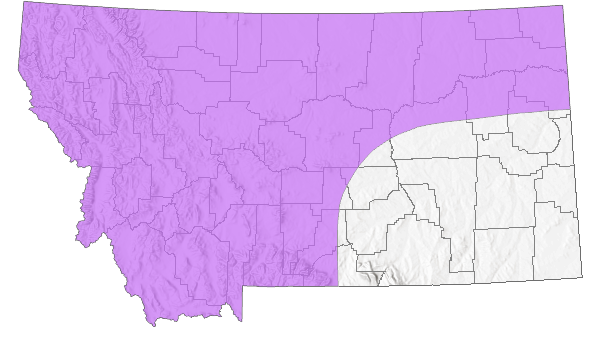
 Native
Native
Western Hemisphere Range
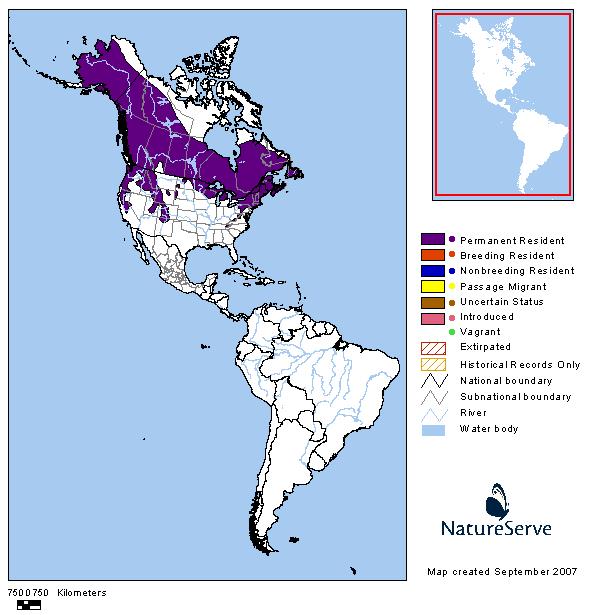
Observations in Montana Natural Heritage Program Database
Number of Observations: 1522
(Click on the following maps and charts to see full sized version)
Map Help and Descriptions
Relative Density
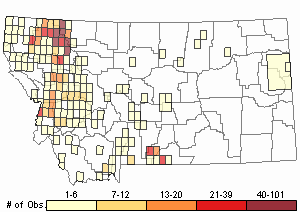
Recency
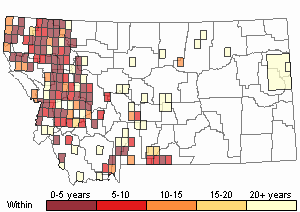

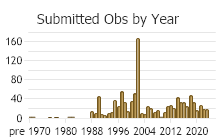
 (Observations spanning multiple months or years are excluded from time charts)
(Observations spanning multiple months or years are excluded from time charts)
Migration
Non-migratory.
Habitat
In western MT, apparently preferred fairly dense stands of young pole-sized timber with some use of more open stands, openings, and edges (Adams 1959, Koehler et al. 1979). Uses dense riparian thickets in eastern Montana (Hoffmann et al. 1969).
Ecological Systems Associated with this Species
- Details on Creation and Suggested Uses and Limitations
How Associations Were Made
We associated the use and habitat quality (common or occasional) of each of the 82 ecological systems mapped in Montana for
vertebrate animal species that regularly breed, overwinter, or migrate through the state by:
- Using personal observations and reviewing literature that summarize the breeding, overwintering, or migratory habitat requirements of each species (Dobkin 1992, Hart et al. 1998, Hutto and Young 1999, Maxell 2000, Foresman 2012, Adams 2003, and Werner et al. 2004);
- Evaluating structural characteristics and distribution of each ecological system relative to the species' range and habitat requirements;
- Examining the observation records for each species in the state-wide point observation database associated with each ecological system;
- Calculating the percentage of observations associated with each ecological system relative to the percent of Montana covered by each ecological system to get a measure of "observations versus availability of habitat".
Species that breed in Montana were only evaluated for breeding habitat use, species that only overwinter in Montana were only evaluated for overwintering habitat use, and species that only migrate through Montana were only evaluated for migratory habitat use.
In general, species were listed as associated with an ecological system if structural characteristics of used habitat documented in the literature were present in the ecological system or large numbers of point observations were associated with the ecological system.
However, species were not listed as associated with an ecological system if there was no support in the literature for use of structural characteristics in an ecological system,
even if point observations were associated with that system.
Common versus occasional association with an ecological system was assigned based on the degree to which the structural characteristics of an ecological system matched the preferred structural habitat characteristics for each species as represented in scientific literature.
The percentage of observations associated with each ecological system relative to the percent of Montana covered by each ecological system was also used to guide assignment of common versus occasional association.
If you have any questions or comments on species associations with ecological systems, please contact the Montana Natural Heritage Program's Senior Zoologist.
Suggested Uses and Limitations
Species associations with ecological systems should be used to generate potential lists of species that may occupy broader landscapes for the purposes of landscape-level planning.
These potential lists of species should not be used in place of documented occurrences of species (this information can be requested at:
mtnhp.mt.gov/requests) or systematic surveys for species and evaluations of habitat at a local site level by trained biologists.
Users of this information should be aware that the land cover data used to generate species associations is based on imagery from the late 1990s and early 2000s and was only intended to be used at broader landscape scales.
Land cover mapping accuracy is particularly problematic when the systems occur as small patches or where the land cover types have been altered over the past decade.
Thus, particular caution should be used when using the associations in assessments of smaller areas (e.g., evaluations of public land survey sections).
Finally, although a species may be associated with a particular ecological system within its known geographic range, portions of that ecological system may occur outside of the species' known geographic range.
Literature Cited
- Adams, R.A. 2003. Bats of the Rocky Mountain West; natural history, ecology, and conservation. Boulder, CO: University Press of Colorado. 289 p.
- Dobkin, D. S. 1992. Neotropical migrant land birds in the Northern Rockies and Great Plains. USDA Forest Service, Northern Region. Publication No. R1-93-34. Missoula, MT.
- Foresman, K.R. 2012. Mammals of Montana. Second edition. Mountain Press Publishing, Missoula, Montana. 429 pp.
- Hart, M.M., W.A. Williams, P.C. Thornton, K.P. McLaughlin, C.M. Tobalske, B.A. Maxell, D.P. Hendricks, C.R. Peterson, and R.L. Redmond. 1998. Montana atlas of terrestrial vertebrates. Montana Cooperative Wildlife Research Unit, University of Montana, Missoula, MT. 1302 p.
- Hutto, R.L. and J.S. Young. 1999. Habitat relationships of landbirds in the Northern Region, USDA Forest Service, Rocky Mountain Research Station RMRS-GTR-32. 72 p.
- Maxell, B.A. 2000. Management of Montana's amphibians: a review of factors that may present a risk to population viability and accounts on the identification, distribution, taxonomy, habitat use, natural history, and the status and conservation of individual species. Report to U.S. Forest Service Region 1. Missoula, MT: Wildlife Biology Program, University of Montana. 161 p.
- Werner, J.K., B.A. Maxell, P. Hendricks, and D. Flath. 2004. Amphibians and reptiles of Montana. Missoula, MT: Mountain Press Publishing Company. 262 p.
- Commonly Associated with these Ecological Systems
Alpine Systems
Forest and Woodland Systems
Grassland Systems
Human Land Use
Recently Disturbed or Modified
Shrubland, Steppe and Savanna Systems
Wetland and Riparian Systems
- Occasionally Associated with these Ecological Systems
Forest and Woodland Systems
Wetland and Riparian Systems
Food Habits
Spring and summer: forbs and grasses. Fall and winter: more shrubs and sometimes conifer needles. Occasionally reingests feces. Sometimes eats sand (Adams 1959).
Ecology
Home ranges may overlap (Adams 1959).
Reproductive Characteristics
Breeding season late February to early July. First pregnancy noticeable in late March. Lactation from late April to late September. 2.8 to 2.9 litters/year. 2.6 to 3.0 young/litter (Adams 1959).
Stewardship Responsibility
References
- Literature Cited AboveLegend:
 View Online Publication
View Online Publication Adams, L. 1959. An analysis of a population of snowshoe hares in northwestern Montana. Ecol. Monogr. 29(2):141-170.
Adams, L. 1959. An analysis of a population of snowshoe hares in northwestern Montana. Ecol. Monogr. 29(2):141-170. Koehler, G.M., M.G. Hornocker, and H.S. Hash. 1979. Lynx movements and habitat use in Montana. Canadian Field-Naturalist 93:441-442.
Koehler, G.M., M.G. Hornocker, and H.S. Hash. 1979. Lynx movements and habitat use in Montana. Canadian Field-Naturalist 93:441-442.
- Additional ReferencesLegend:
 View Online Publication
View Online Publication
Do you know of a citation we're missing? Adelman, E.B. 1979. A survey of the nongame mammals in the Upper Rattlesnake Creek drainage of western Montana. M.S. thesis. University of Montana, Missoula. 129 pp.
Adelman, E.B. 1979. A survey of the nongame mammals in the Upper Rattlesnake Creek drainage of western Montana. M.S. thesis. University of Montana, Missoula. 129 pp. Anaconda Minerals Company, and Camp, Dresser & McKee. 1981. Anaconda Stillwater Project 6-month environmental baseline report. CDM Project No. 3139. Vol. I Appendix. Jan. 15, 1981.
Anaconda Minerals Company, and Camp, Dresser & McKee. 1981. Anaconda Stillwater Project 6-month environmental baseline report. CDM Project No. 3139. Vol. I Appendix. Jan. 15, 1981. Beak Consultants, Inc. 1983. Wildlife. January 1983. In Stillwater Project Environmental Studies. Addendum A, Wildlife. Vol. I. Tech. Report No. 7. 1982.
Beak Consultants, Inc. 1983. Wildlife. January 1983. In Stillwater Project Environmental Studies. Addendum A, Wildlife. Vol. I. Tech. Report No. 7. 1982. Brand, C.J. and L.B. Keith. 1979. Lynx demography during a snowshoe hare decline in Alberta. Journal of Wildlife Management 43(4):827-849.
Brand, C.J. and L.B. Keith. 1979. Lynx demography during a snowshoe hare decline in Alberta. Journal of Wildlife Management 43(4):827-849. Brand, C.J., L.B. Keith and C.A. Fischer. 1976. Lynx responses to changing snowshoe hare densities in central Alberta. Journal of Wildlife Management 40(3):416-428.
Brand, C.J., L.B. Keith and C.A. Fischer. 1976. Lynx responses to changing snowshoe hare densities in central Alberta. Journal of Wildlife Management 40(3):416-428. Burdorfer, W., V. F. Newhouse, and L. A. Thomas. 1961. Isolation of California encephalitis virus from the blood of a snowshoe hare (Lepus americanus) in Western Montana. Am. J. Hygiene. 73:344-349.
Burdorfer, W., V. F. Newhouse, and L. A. Thomas. 1961. Isolation of California encephalitis virus from the blood of a snowshoe hare (Lepus americanus) in Western Montana. Am. J. Hygiene. 73:344-349. Burleigh, W.E. 1978. Seasonal distribution and historical decline of the Rocky Mountain goat in the Cabinet Mountains, Montana. M.S. thesis. University of Montana, Missoula. 110 pp.
Burleigh, W.E. 1978. Seasonal distribution and historical decline of the Rocky Mountain goat in the Cabinet Mountains, Montana. M.S. thesis. University of Montana, Missoula. 110 pp. Butts, T.W. 1992. Lynx (Felis lynx) biology and management: a literature review and annotated bibliography. Missoula, MT: USDA Forest Service, Northern Region. Threatened, Endangered, and Sensitive Program. 114 p. + appendix.
Butts, T.W. 1992. Lynx (Felis lynx) biology and management: a literature review and annotated bibliography. Missoula, MT: USDA Forest Service, Northern Region. Threatened, Endangered, and Sensitive Program. 114 p. + appendix. Butts, T.W., Western Technology and R.L. Eng. 1993. Continental Lime Indian Creek Mine, Townsend, MT. Life of Mine Wildlife Reconnaissance. In Life-of-Mine Amendment. Continental Lime, Inc., Indian Creek Mine & Plant. Vol. 2. October 13, 1992.
Butts, T.W., Western Technology and R.L. Eng. 1993. Continental Lime Indian Creek Mine, Townsend, MT. Life of Mine Wildlife Reconnaissance. In Life-of-Mine Amendment. Continental Lime, Inc., Indian Creek Mine & Plant. Vol. 2. October 13, 1992. Chapman, J.A., and G.A. Feldhamer. 1982. Wild mammals of North America: biology, management, and economics. Johns Hopkins University Press, Baltimore, Maryland.
Chapman, J.A., and G.A. Feldhamer. 1982. Wild mammals of North America: biology, management, and economics. Johns Hopkins University Press, Baltimore, Maryland. Cheng, Ellen. 2010. Climate change, gene flow, and the legendary synchrony of Snowshoe Hares. PhD Dissertation. University of Montana. Missoula, MT.
Cheng, Ellen. 2010. Climate change, gene flow, and the legendary synchrony of Snowshoe Hares. PhD Dissertation. University of Montana. Missoula, MT. Cramer, P.C. 1992. Small mammal diversity and abundance in Douglas Fir old growth forests. M.Sc. Thesis. Bozeman, MT: Montana State University. 64 p.
Cramer, P.C. 1992. Small mammal diversity and abundance in Douglas Fir old growth forests. M.Sc. Thesis. Bozeman, MT: Montana State University. 64 p. Dice, L.R. 1923. Mammal associations and habitats of the Flathead Lake Region, Montana. Ecology 4(3): 247-260.
Dice, L.R. 1923. Mammal associations and habitats of the Flathead Lake Region, Montana. Ecology 4(3): 247-260. Dolbeer, W.R. and R.A. Clark. 1975. Population ecology of snowshoe hares in the central Rocky Mountains. J. Wild. Manage. 39:535-549.
Dolbeer, W.R. and R.A. Clark. 1975. Population ecology of snowshoe hares in the central Rocky Mountains. J. Wild. Manage. 39:535-549. Eng, R.L. 1976. Wildlife Baseline Study [for West Fork of the Stillwater and Picket Pin drainages]
Eng, R.L. 1976. Wildlife Baseline Study [for West Fork of the Stillwater and Picket Pin drainages] Farmer, Patrick J., and Thomas W. Butts, Western Technology & Eng., Inc., Helena, MT., 1994, McDonald Project Terrestrial Wildlife Study, November 1989 - November 1993. April 1994. In McDonald Gold Project: Wildlife & Fisheries. [#18]. Seven-up Pete Joint Venture, Lincoln, MT. Unpub. No date.
Farmer, Patrick J., and Thomas W. Butts, Western Technology & Eng., Inc., Helena, MT., 1994, McDonald Project Terrestrial Wildlife Study, November 1989 - November 1993. April 1994. In McDonald Gold Project: Wildlife & Fisheries. [#18]. Seven-up Pete Joint Venture, Lincoln, MT. Unpub. No date. Farmer, Patrick. J., et al., Western Technology and Eng., Inc., Helena, MT., 1984, Montana Tunnels Project Baseline Terrestrial Wildlife Study. December 14, 1984. In Application for a Hard Rock Operating Permit, Montana Tunnels Project, Jefferson County, Montana. Vol. 3. Environmental Baseline Reports. (Centennial Minerals, Inc., Hydrometrics, 1984?)
Farmer, Patrick. J., et al., Western Technology and Eng., Inc., Helena, MT., 1984, Montana Tunnels Project Baseline Terrestrial Wildlife Study. December 14, 1984. In Application for a Hard Rock Operating Permit, Montana Tunnels Project, Jefferson County, Montana. Vol. 3. Environmental Baseline Reports. (Centennial Minerals, Inc., Hydrometrics, 1984?) Flathead National Forest. U.S. Forest Service., 1993, Wildlife landscape evaluation, Swan Valley. Draft Report.
Flathead National Forest. U.S. Forest Service., 1993, Wildlife landscape evaluation, Swan Valley. Draft Report. Foresman, K.R. 2001. The wild mammals of Montana. American Society of Mammalogists, Special Publication Number 12. Lawrence, KS. 278 pp.
Foresman, K.R. 2001. The wild mammals of Montana. American Society of Mammalogists, Special Publication Number 12. Lawrence, KS. 278 pp. Foresman, K.R. 2012. Mammals of Montana. Second edition. Mountain Press Publishing, Missoula, Montana. 429 pp.
Foresman, K.R. 2012. Mammals of Montana. Second edition. Mountain Press Publishing, Missoula, Montana. 429 pp. Fox, J.F. 1978. Forest fires and the snowshoe hare-Canada lynx cycle. Oecologia 31:349-374.
Fox, J.F. 1978. Forest fires and the snowshoe hare-Canada lynx cycle. Oecologia 31:349-374. Hoffmann, R.S. and D.L. Pattie. 1968. A guide to Montana mammals: identification, habitat, distribution, and abundance. Missoula, MT: University of Montana. 133 p.
Hoffmann, R.S. and D.L. Pattie. 1968. A guide to Montana mammals: identification, habitat, distribution, and abundance. Missoula, MT: University of Montana. 133 p. Hoffmann, R.S., P.L. Wright, and F.E. Newby. 1969. The distribution of some mammals in Montana. I. Mammals other than bats. Journal of Mammalogy 50(3): 579-604.
Hoffmann, R.S., P.L. Wright, and F.E. Newby. 1969. The distribution of some mammals in Montana. I. Mammals other than bats. Journal of Mammalogy 50(3): 579-604. Holbrook, J.D., J.R. Squires, L.E. Olson, N.J. DeCesare, and R.L. Lawrence. 2017. Understanding and predicting habitat for wildlife conservation: the case of Canada Lynx at the range periphery. Ecosphere 8(9):e01939.
Holbrook, J.D., J.R. Squires, L.E. Olson, N.J. DeCesare, and R.L. Lawrence. 2017. Understanding and predicting habitat for wildlife conservation: the case of Canada Lynx at the range periphery. Ecosphere 8(9):e01939. Johnson, L.J. 1960. Mammal studies on the Lubrecht Forest, Montana: a preliminary report. Proc. Mont. Acad. Sci. 20: 40-47.
Johnson, L.J. 1960. Mammal studies on the Lubrecht Forest, Montana: a preliminary report. Proc. Mont. Acad. Sci. 20: 40-47. Joslin, Gayle, and Heidi B. Youmans. 1999. Effects of recreation on Rocky Mountain wildlife: a review for Montana. [Montana]: Montana Chapter of the Wildlife Society.
Joslin, Gayle, and Heidi B. Youmans. 1999. Effects of recreation on Rocky Mountain wildlife: a review for Montana. [Montana]: Montana Chapter of the Wildlife Society. Koehler, G.M. 1990. Population and habitat characteristics of lynx and snowshoe hares in north central Washington. Canadian Journal of Zoology 68:845-851.
Koehler, G.M. 1990. Population and habitat characteristics of lynx and snowshoe hares in north central Washington. Canadian Journal of Zoology 68:845-851. Koehler, G.M. 1990. Snowshoe hare, Lepus americanus, use of forest successional stages and population changes during 1985-1989 in north-central Washington. The Canadian Field-Naturalist 105:291-293.
Koehler, G.M. 1990. Snowshoe hare, Lepus americanus, use of forest successional stages and population changes during 1985-1989 in north-central Washington. The Canadian Field-Naturalist 105:291-293. Koehler, G.M. and J.D. Brittell. 1990. Managing spruce-fir habitat for lynx and snowshoe hares. Journal of Forestry 88:10-14.
Koehler, G.M. and J.D. Brittell. 1990. Managing spruce-fir habitat for lynx and snowshoe hares. Journal of Forestry 88:10-14. Kosterman, M.K., J.R. Squires, J.D. Holbrook, D.H. Pletscher, and M. Hebblewhite. 2018. Forest structure provides the income for reproductive success in a southern population of Canada Lynx. Ecological Applications 28(4):1032-1043.
Kosterman, M.K., J.R. Squires, J.D. Holbrook, D.H. Pletscher, and M. Hebblewhite. 2018. Forest structure provides the income for reproductive success in a southern population of Canada Lynx. Ecological Applications 28(4):1032-1043. Kumar, Alexander. 2020. Biotic and abiotic drivers of acyclic snowshoe hare population dynamics in a spatiotemporally complex system. PhD Dissertation. University of Montana. Missoula, MT.
Kumar, Alexander. 2020. Biotic and abiotic drivers of acyclic snowshoe hare population dynamics in a spatiotemporally complex system. PhD Dissertation. University of Montana. Missoula, MT. Kurzen, M.D. 2019. Snowshoe hare habitat use and silvicultural influences in the Greater Yellowstone Ecosystem. M.Sc. Thesis. Bozeman, MT: Montana State University. 56 p.
Kurzen, M.D. 2019. Snowshoe hare habitat use and silvicultural influences in the Greater Yellowstone Ecosystem. M.Sc. Thesis. Bozeman, MT: Montana State University. 56 p. Martin, Steve A., ECON, Inc., Helena, MT., 1982, Flathead Project Wildlife Report, 1981-1982. November 30, 1982.
Martin, Steve A., ECON, Inc., Helena, MT., 1982, Flathead Project Wildlife Report, 1981-1982. November 30, 1982. Nagorsen, D.W. 1985. A morphometric study of geographic variation in the snowshoe hare (Lepus americanus). Canadian Journal of Zoology 63:567-579.
Nagorsen, D.W. 1985. A morphometric study of geographic variation in the snowshoe hare (Lepus americanus). Canadian Journal of Zoology 63:567-579. OEA Research, Helena, MT., 1982, Beal Mine Wildlife Report. June 17, 1982.
OEA Research, Helena, MT., 1982, Beal Mine Wildlife Report. June 17, 1982. Oechsli, L.M. 2000. Ex-urban development in the Rocky Mountain West: consequences for native vegetation, wildlife diversity, and land-use planning in Big Sky, Montana. M.Sc. Thesis. Montana State University, Bozeman. 73 p.
Oechsli, L.M. 2000. Ex-urban development in the Rocky Mountain West: consequences for native vegetation, wildlife diversity, and land-use planning in Big Sky, Montana. M.Sc. Thesis. Montana State University, Bozeman. 73 p. Parker, G.R., J.W. Maxwell, L.D. Morton, and G.E.D. Smith. 1983. The ecology of lynx (Lynx canadensis) on Cape Breton Island. Canadian Journal of Zoology 61:770-786.
Parker, G.R., J.W. Maxwell, L.D. Morton, and G.E.D. Smith. 1983. The ecology of lynx (Lynx canadensis) on Cape Breton Island. Canadian Journal of Zoology 61:770-786. Pattie, D.L. and N.A. M. Verbeek. 1967. Alpine mammals of the Beartooth Plateau. Northwest Science 41(3): 110-117.
Pattie, D.L. and N.A. M. Verbeek. 1967. Alpine mammals of the Beartooth Plateau. Northwest Science 41(3): 110-117. Plopper, C.E. 1968. Insular and mainland populations of Peromyscus maniculatus at Flathead Lake, Montana. M.S. thesis. University of Montana, Missoula. 91 pp.
Plopper, C.E. 1968. Insular and mainland populations of Peromyscus maniculatus at Flathead Lake, Montana. M.S. thesis. University of Montana, Missoula. 91 pp. Reichel, J.D., D.L. Genter and E. Atkinson. 1992. Sensitive animal species in the Elkhorn and Big Belt Mountains of the Helena National Forest. Unpublished report to the Helena National Forest. Montana Natural Heritage Program, Helena. 158 p.
Reichel, J.D., D.L. Genter and E. Atkinson. 1992. Sensitive animal species in the Elkhorn and Big Belt Mountains of the Helena National Forest. Unpublished report to the Helena National Forest. Montana Natural Heritage Program, Helena. 158 p. Reid, F. 2006. Peterson Field Guide to Mammals of North America, 4th Edition. Houghton Mifflin Company: Boston and New York, 608 pp.
Reid, F. 2006. Peterson Field Guide to Mammals of North America, 4th Edition. Houghton Mifflin Company: Boston and New York, 608 pp. Rivera, Pilar T. 2005. Fecal pellet deposition and disappearance rates for Snowshoe Hares near Seeley Lake, Montana
Rivera, Pilar T. 2005. Fecal pellet deposition and disappearance rates for Snowshoe Hares near Seeley Lake, Montana Rust, H. J. 1946. Mammals of northern Idaho. J. Mammal. 27(4): 308-327.
Rust, H. J. 1946. Mammals of northern Idaho. J. Mammal. 27(4): 308-327. Shick, Katharine. 2003. Influence of stand-level vegetation and landscape composition on the abundance of Snowshoe Hares (Lepus americanus) in managed forest stands in western Montana. M.S. Thesis. University of Montana. Missoula, MT.
Shick, Katharine. 2003. Influence of stand-level vegetation and landscape composition on the abundance of Snowshoe Hares (Lepus americanus) in managed forest stands in western Montana. M.S. Thesis. University of Montana. Missoula, MT. Sinclair, A. R. E., C. J. Krebs, J. N. M. Smith, and S. Boutin. 1988. Population biology of snowshoe hares. III. Nutrition, plant secondary compounds and food limitation. J. Anim. Ecol. 57:787-806.
Sinclair, A. R. E., C. J. Krebs, J. N. M. Smith, and S. Boutin. 1988. Population biology of snowshoe hares. III. Nutrition, plant secondary compounds and food limitation. J. Anim. Ecol. 57:787-806. Stearns-Roger Inc., 1975, Environmental baseline information of the Mount Vernon Region, Montana. January 31, 1975.
Stearns-Roger Inc., 1975, Environmental baseline information of the Mount Vernon Region, Montana. January 31, 1975. Thier, T. J. 1990. Population characteristics and the effects of hunting on black bears in a portion of northwestern Montana. M.S. thesis. University of Montana, Missoula. 100 pp.
Thier, T. J. 1990. Population characteristics and the effects of hunting on black bears in a portion of northwestern Montana. M.S. thesis. University of Montana, Missoula. 100 pp. Thompson, I. D., I. J. Davidson, S. O'Donnell and F. Brazeau. 1989. Use of track transects to measure the relative occurrence of some boreal mammals in uncut forest and regeneration stands. Can. J. Zool. 67:1816-1823.
Thompson, I. D., I. J. Davidson, S. O'Donnell and F. Brazeau. 1989. Use of track transects to measure the relative occurrence of some boreal mammals in uncut forest and regeneration stands. Can. J. Zool. 67:1816-1823. Thompson, Richard W., Western Resource Dev. Corp., Boulder, CO., 1996, Wildlife baseline report for the Montana [Montanore] Project, Lincoln and Sanders counties, Montana. In Application for a Hard Rock Operating Permit and Proposed Plan of Operation, Montanore Project, Lincoln and Sanders Counties, Montana. Vol. 5. Stroiazzo, John. Noranda Minerals Corp., Libby, MT. Revised September 1996.
Thompson, Richard W., Western Resource Dev. Corp., Boulder, CO., 1996, Wildlife baseline report for the Montana [Montanore] Project, Lincoln and Sanders counties, Montana. In Application for a Hard Rock Operating Permit and Proposed Plan of Operation, Montanore Project, Lincoln and Sanders Counties, Montana. Vol. 5. Stroiazzo, John. Noranda Minerals Corp., Libby, MT. Revised September 1996. TVX Mineral Hill Mine, Amerikanuak, Inc., Gardiner, MT., 2002, Yearly summary of wildlife observation reports. 1990-2002 Letter reports.
TVX Mineral Hill Mine, Amerikanuak, Inc., Gardiner, MT., 2002, Yearly summary of wildlife observation reports. 1990-2002 Letter reports. Tweten, R.G. 1984. Baseline survey of furbearing mammals within the South Fork drainage Sun River, Montana. M.Sc. Thesis. Bozeman, MT: Montana State University. 63 p.
Tweten, R.G. 1984. Baseline survey of furbearing mammals within the South Fork drainage Sun River, Montana. M.Sc. Thesis. Bozeman, MT: Montana State University. 63 p. Walker, Carly J., 2005, Influences of landscape structure on Snowshoe Hare populations in fragmented forests. M.S. Thesis. University of Montana. Missoula, MT.
Walker, Carly J., 2005, Influences of landscape structure on Snowshoe Hare populations in fragmented forests. M.S. Thesis. University of Montana. Missoula, MT. Weckwerth, R. P. 1957. The relationship between the marten population and the abundance of small mammals in Glacier National Park. M.S. thesis. University of Montana, Missoula. 76 pp.
Weckwerth, R. P. 1957. The relationship between the marten population and the abundance of small mammals in Glacier National Park. M.S. thesis. University of Montana, Missoula. 76 pp. WESTECH Env. Services, Inc., Helena, MT., 2000, Reconnaissance of Wildlife and Fisheries Resources at the Ruby Garnet Alder Gulch Property. May 24, 2000. In Application for an Operating Permit and Proposed Plan of Operations, Alder Gulch Mine Project, Mad
WESTECH Env. Services, Inc., Helena, MT., 2000, Reconnaissance of Wildlife and Fisheries Resources at the Ruby Garnet Alder Gulch Property. May 24, 2000. In Application for an Operating Permit and Proposed Plan of Operations, Alder Gulch Mine Project, Mad Westech, Inc. [Western Technology and Engineering]. 1989. Reconnaissance of terrestrial wildlife resources in the Pauper's Dream project vicinity, Aug. 1988. Prepared for Hydrometrics, Inc., Helena, MT. 22 pp.
Westech, Inc. [Western Technology and Engineering]. 1989. Reconnaissance of terrestrial wildlife resources in the Pauper's Dream project vicinity, Aug. 1988. Prepared for Hydrometrics, Inc., Helena, MT. 22 pp. Western Technology and Engineering, Inc., Helena, MT., 1987, Reconnaissance: Terrestrial wildlife resources, Rimini access road, Paupers Dream Project. December 1987. In Pangea Mining Co., Inc., Paupers Dream Project.
Western Technology and Engineering, Inc., Helena, MT., 1987, Reconnaissance: Terrestrial wildlife resources, Rimini access road, Paupers Dream Project. December 1987. In Pangea Mining Co., Inc., Paupers Dream Project. Western Technology and Engineering, Inc., Helena, MT., 1989, Reconnaissance of terrestrial wildlife resources in the Basin Creek Mine Amendment 5 vicinity, 1988-1989. November 1989. In Basin Creek Mine Permit Amendment No. 5 - Paupers Pit Southwest, Block B and leach Pad No. 3. Basin Creek Mining, Inc. (Pegasus Gold Corp.). For Montana Dept. of State Lands and USFS Deer Lodge NF.
Western Technology and Engineering, Inc., Helena, MT., 1989, Reconnaissance of terrestrial wildlife resources in the Basin Creek Mine Amendment 5 vicinity, 1988-1989. November 1989. In Basin Creek Mine Permit Amendment No. 5 - Paupers Pit Southwest, Block B and leach Pad No. 3. Basin Creek Mining, Inc. (Pegasus Gold Corp.). For Montana Dept. of State Lands and USFS Deer Lodge NF. Williams, O. 1955. Distribution of mice and shrews in a Colorado montane forest. J. Mammal. 36(2): 221-231.
Williams, O. 1955. Distribution of mice and shrews in a Colorado montane forest. J. Mammal. 36(2): 221-231. Wolfe, M.L., N.V. Debyln, C.S. Winchell and T.R. McCabe. 1982. Snowshoe hare cover relationships in northern Utah. J. Wildl. Manage. 46:662-670.
Wolfe, M.L., N.V. Debyln, C.S. Winchell and T.R. McCabe. 1982. Snowshoe hare cover relationships in northern Utah. J. Wildl. Manage. 46:662-670. Zimmer, J.P. 2004. Winter habitat use and diet of Snowshoe Hares in the Gardiner, Montana area. M.Sc. Thesis. Bozeman, MT: Montana State University. 65 p.
Zimmer, J.P. 2004. Winter habitat use and diet of Snowshoe Hares in the Gardiner, Montana area. M.Sc. Thesis. Bozeman, MT: Montana State University. 65 p.
- Web Search Engines for Articles on "Snowshoe Hare"
- Additional Sources of Information Related to "Mammals"





